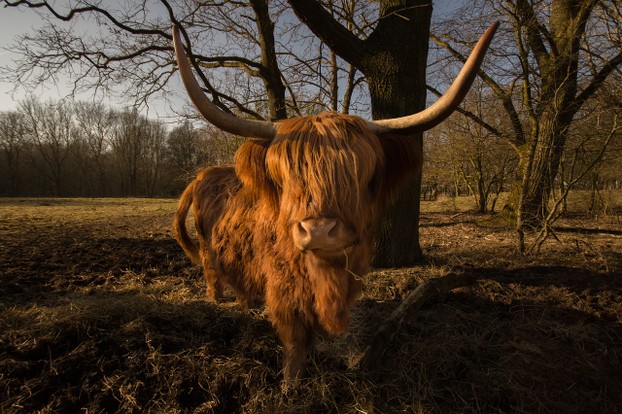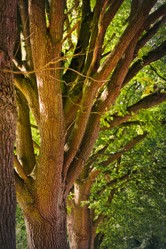The Afon Prysor was born when the melting ice liberated water to spring afresh through the ice-sculpted landscape, and the exuberant juvenile waters scoured their path to the ocean via a gorge that they carved on their course. Thus was Ceunant Llenyrch [Llenyrch Gorge] created. That was ten thousand years ago, as the Ice Age was concluding. The abounding rains that swept in from the Atlantic and the spray from the Rhaeadr Dhu [Black waterfall] Prysor's cascade, created an environment lush for ferns, which have thrived ever since among the trees of the narrow gorge, which at one place is a mere thirty three feet across. Its precipitous sides are not friendly to humans, and so as the rain forest dwindled in extent due to man's exactions Coed Llenyrch [Llenyrch Wood] remained unsullied.Experts suspect that there are places in Ceunant's narrow defile that have never known the footfall of humans. But who is to know?
Ceunant Llenyrch is one out of eight reserves of ancient Celtic rain forest that form the oak woods of the ancient county of Merionydd [pronounced Merionyth.] Only three are available for access to visitors, as the narrow gorges of the other five are too dangerous for tourists to tread. But Llenyrch has been joined to Coed Felinrhyd, a large woodland owned by the National Trust to create a single site that unites Celtic forests into a larger unity. The result is a 755 acre forest in the south of the Snowdonia National Park. Coed [wood] Felinrhyd is accessible to walkers and is very popular.
The uniqueness of the Celtic rainforest habitat lies not in its wildflowers, which are not abundant, but in its ferns, mosses, lichens and liverworts. The shady and wet environment is a dream for ferns, and over two hundred species of lichens, and about the same number of mosses. Some are rare, and recently one thought to have been extinct in Britain since the 1800s was rediscovered clinging to safety in Coed Llynyrch. The wood is also rich in epiphytes, plants that cling to trees and derive their nutrients from the air, rain, dust and plant debris.
Tree species are not unique, but there are some rare ones, such as the sessile oak. This, unlike the peduncular varieties of oak, has acorns with no stem that grow directly from the branches. Felled to near extinction to provide wood for industry and England's war fleets, it survives in isolated, inaccessible spots. There is the downy birch, not a common species.We find hazel and the ever-present rowan.
The woods, with all their mosses and epiphytes, have a Tolkien-like feel to them, and indeed, the great master of fantasy was deeply inspired by the Welsh myths of the Mabinogion, some of which were set in these ancient woodlands. The grave of the mythical king, Pryderi, slain in battle with the trickster god, Gwydion, a Celtic version of the Saxon Woden, was said to have been located in these forests, though no site has ever been identified as its whereabouts.








 Women of the Gospelson 10/11/2025
Women of the Gospelson 10/11/2025
 Religious Gardenson 08/25/2025
Religious Gardenson 08/25/2025
 Doctor of the Church: John Henry Newmanon 08/03/2025
Doctor of the Church: John Henry Newmanon 08/03/2025
 Restoring the Palm Houseon 07/16/2025
Restoring the Palm Houseon 07/16/2025



Comments
I think that each animal family would have its own territory.
Thank you for your answer Oct. 30, 2018, to my previous question Oct. 29, 2018!
Online sources associate the Eurasian beaver with near-extinction hunting and with 20th- and 21st-century reintroductions in Asian and European countries.
Might American (Castor canadensis) and Eurasian/European (Castor fiber) beaver populations have their own territories or might their ranges overlap in the British Isles?
Celtic refers to the cultural/broad ethnic group inhabiting the west of the British Isles. Scholars used to class the Scots, Cornish, Welsh, Irish, Manx and Bretons as Celts.As this forest is in Wales it is named the Celtic Rain Forest. Nowadays Celtic is a broad term to denote a cultural and linguistic rather than an ethic group. A colleague at work once told me that I looked Celtic, almost certainly because I have Irish features.
I am really happy that these areas of forest reserves are inaccessible. Only due to the difficult terrains have these rainforests survived. Many of India's jungles and world's rainforests have fallen prey to illegal poachers and thieves who steal timbre. Amazon's rainforests are threatened and chopping has not stopped. Many of human's actions are irreversible, temperature changes and eco-systems being threatened, there is a really long list of abuse to the living planet. I wonder why the forests are called celtic rainforest.
The five reserves are not impossible of access, but it has been decided that safety concerns mean that only forest staff and scientists,properly equipped can enter them. There may be electronic surveillance present in the form of cameras, in fact there often is, but I don't know the details.
Beavers have been introduced from North America.
frankbeswick, Thank you for the tour of a temperate rainforest and some of its life forms. There are temperate rainforests in North America from Alaska through California and in Appalachia: I love their humidity, moisture, sights, smells, sounds and wildlife.
Is there some kind of a human and technological surveillance system in effect for the five reserves that cannot be accessed by visitors? Researchers must be able to access them, correct?
Where would the beaver be introduced from?
These cattle are bred to suit their environment, which can be cold and wet. They would be unsuitable for the warmer parts of the state's.
Such groups are vital to our global health and while not everyone understands the importance of such collaborations I do and many others as well, the positive actions hopefully out weigh the negative.
I have always thought cows were adorable but highland cattle are gorgeous, it is amazing the difference in highland cattle as compared to cattle in the states.
There are temperate rain forests in South Chile, though the flora of these Valdivian forests differs from the flora of the Celtic ones.
The climatics of the Celtic rain .forest differ from those of the tropical rain forests. The latter rely on convectional rainfall in many places, though the forests on the Eastern Andes get much rain from the Pacific ocean. The Celtic forest relies on westward-moving Atlantic weather systems; and Western Britain and Ireland in particular benefit from the warming effects of the North Atlantic Drift.